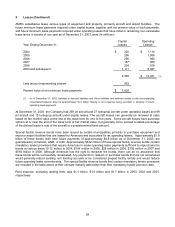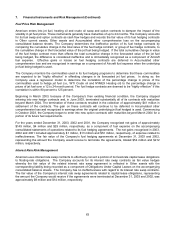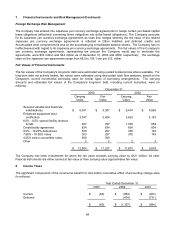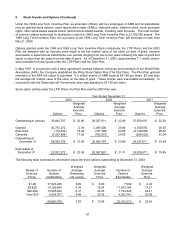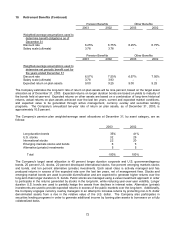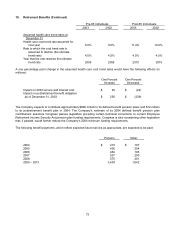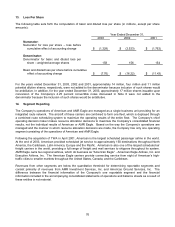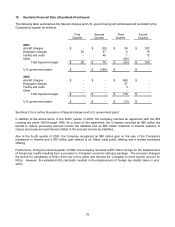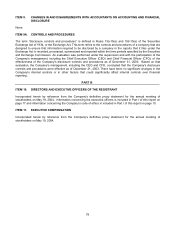American Airlines 2003 Annual Report Download - page 71
Download and view the complete annual report
Please find page 71 of the 2003 American Airlines annual report below. You can navigate through the pages in the report by either clicking on the pages listed below, or by using the keyword search tool below to find specific information within the annual report.69
10. Retirement Benefits
All regular employees of the Company are eligible to participate in pension plans. The defined benefit plans
provide benefits for participating employees based on years of service and average compensation for a specified
period of time before retirement. The Company uses a December 31 measurement date for all of its defined
benefit plans. Airline pilots also participate in a defined contribution plan for which Company contributions are
determined as a percentage of participant compensation.
Effective January 1, 2001, American established a defined contribution plan for non-contract employees in which
the Company will match the employees before-tax contribution on a dollar-for-dollar basis, up to 5.5 percent of
their pensionable pay. During 2000, American provided a one-time election for current non-contract employees to
remain in the defined benefit plan or discontinue accruing future credited service in the defined benefit plan as of
January 1, 2001 and begin participation in the defined contribution plan. Effective January 1, 2002, all new non-
contract employees of the Company become members of the defined contribution plan.
In addition to pension benefits, other postretirement benefits, including certain health care and life insurance
benefits (which provide secondary coverage to Medicare), are provided to retired employees. The amount of
health care benefits is limited to lifetime maximums as outlined in the plan. Substantially all regular employees of
American and employees of certain other subsidiaries may become eligible for these benefits if they satisfy
eligibility requirements during their working lives.
Certain employee groups make contributions toward funding a portion of their retiree health care benefits during
their working lives. AMR funds benefits as incurred and makes contributions to match employee prefunding.
In connection with the acquisition of TWA in April 2001, the Company assumed certain retiree benefit plan
liabilities of TWA, primarily its postretirement benefit obligation. As such, the following information reflects the
inclusion of these obligations from the date of acquisition. In addition, effective January 1, 2002, TWA LLC
employees were eligible to begin participation in American’s pension plans. However, these employees were not
granted prior credited service.
In the second quarter of 2003, as a result of the Labor Agreements and Management Reductions discussed in
Note 2, the Company remeasured its defined benefit pension plans. The significant actuarial assumptions used
for the remeasurement were the same as those used as of December 31, 2002, except for the discount rate and
salary scale, which were lowered to 6.50 percent, and 2.78 percent through 2008 and 3.78 percent thereafter,
respectively. In addition, assumptions with respect to interest rates used to discount lump sum benefit payments
available under certain plans were updated. As a result of workforce reductions related to the Labor Agreements
and Management Reductions, the Company recognized a curtailment loss of $46 million related to its defined
benefit pension plans, which is included in Special charges in the accompanying consolidated statement of
operations. Net periodic benefit cost for defined benefit pension plans includes eight months of expense calculated
based upon the revised measurement.
In December 2003, the President signed the Medicare Prescription Drug, Improvement and Modernization Act of
2003 (the Modernization Act), which introduces a prescription drug benefit under Medicare, into law. In January
2004, the Financial Accounting Standards Board (FASB) issued a FASB Staff Position which permits companies
to elect to defer accounting for the effects of the Modernization Act. The Company has not elected this deferral
and has recognized the effect of the Modernization Act in the calculation of its postretirement benefit liability as of
December 31, 2003. The effect of the Modernization Act was to reduce the Company’s accumulated
postretirement benefit obligation (APBO) by $415 million by decreasing unrecognized net actuarial losses. This
decrease is due to a reduction in the expected per capita claims cost along with a reduction in the expected rates
of participation in the plan. The decrease in the APBO will be reflected in the Company’s postretirement benefits
expense in future periods through amortization of unrecognized gains/losses. Additionally, the service and interest
cost components of postretirement benefits expense will be reduced in future periods. Final authoritative guidance
on accounting for the Modernization Act has not been issued and could require the Company to change previously
reported information.


